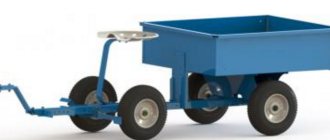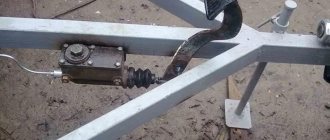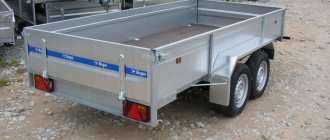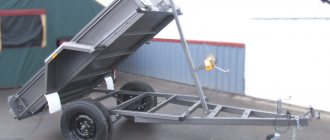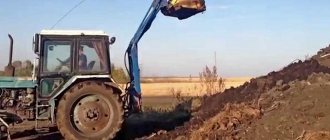A tractor cart is mechanical equipment for transporting goods. The structural and functional characteristics of the trailer must correspond to the technical parameters of the machine to which it will be connected.
It is quite possible to make a tractor trailer with your own hands. The process is quite simple if you follow the algorithm.
Wheels
Wheels for the trolley can be used from a motorized stroller. The hub comes assembled. The ends of the axle must be sharpened so that they match the diameter of the bearings.
Spepka with walk-behind tractor
Using a cantilever beam, the trolley is connected to the walk-behind tractor. The upper part of the console is similar to the outline of the holder. It is mounted in the bracket of the walk-behind tractor attachments.
When the trolley is used in difficult conditions, it is necessary that its connection to the walk-behind tractor be articulated.
The drawbar must be inserted into the tubular joint housing. The drawbar is fixed with a stop ring. With this design, you can achieve independence of the wheels of the trolley from the wheels of the walk-behind tractor. When moving with a loaded trolley, this allows you to better control the walk-behind tractor.
Rotary unit - diagram
3.6 Bearings (36206);
5. Spacer sleeve;
7. Remote bushing;
The driver will sit on a cushion that has medium hardness, because it is made of wood. The driver's seat is in front of the body. Control is carried out from the trolley. The operator's hands hold the handle of the walk-behind tractor.
This is interesting: Chuvashpiller mini tractors, models - technical characteristics
Features of making a homemade cart
First of all, before directly assembling the tractor trailer, the manufacturer will need to study detailed diagrams, which should indicate the dimensions of the parts used, as well as the order and method of their installation in the overall structure.
The drawings indicate that the tractor cart should consist of several parts.
Their list includes:
- frame – the main strength element;
- chassis, including wheelbase;
- body;
- lifting part;
- a drawbar with which the trailer will be attached to a utility tractor.
To assemble each of these elements, the manufacturer will need:
- a pair of sheets of steel;
- steel or metal channel;
- blanks made of thick plywood;
- metal pipes;
- chassis block;
- 1–2 pairs of identical wheels;
- electrical connection equipment;
- Bulgarian;
- fasteners.
If you have all the materials and equipment, you can assemble the following types of carts:
- single-axis - the simplest and most popular option. A single-axle tractor trailer can be used to work with any type of agricultural machinery. It can be used to successfully transport bulk, liquid or semi-liquid materials;
- biaxial - they are distinguished by their high resistance to particularly large and heavy luggage.
For unloading, the tractor cart must be equipped with a separate mechanism.
Depending on the principle of operation, carts are divided into the following types:
- tipping randomly - they work on the principle of an ordinary dump truck, which is driven by a mechanical lever;
- forced lifting - in these structures, lifting the body requires the use of technically complex foreign components. Most often, for this purpose, the tractor cart is equipped with an oil pump, engine or car lift.
The most convenient is considered to be a single-axle tractor cart, in which the components of the body are held on the central axis by means of hinges. To make unloading possible, the easiest way is to make a randomly tipping trailer. It will be activated by a lever, which must be equipped with a stopper to reduce the risk of the structure overturning.
Trolley design
A trolley of any design has the following parts:
— a place for the driver;
- trolley with body;
What material is suitable for making a trolley frame?
It is best to prepare a frame for the cart from corners and channels. They can be bought at almost any construction hypermarket or base. It is important to cook the frame very carefully. The design must withstand movement with loads on difficult road sections.
Blank for wheel axle
For the wheel axle, you can use steel circles that have a diameter of 30 millimeters. The axis is connected to the longitudinal hinge by means of welding. It is important to choose an axle so that the wheels are located under the body.
How to make a body for a trolley
You can independently make a body for a trolley from boards that are 20 millimeters thick. Steel corners are attached to the corners of the boards. With their help, the body is attached to the frame with bolts. The best option is folding sides. This way it will be possible to easily remove loads and also place them on the cart.
Wheels - what will suit them?
In principle, wheels can be taken from any agricultural machinery. In addition, some craftsmen use wheels from motorcycles and strollers. But the axle will have to be machined to fit the diameter of the bearings.
Drawbar for single axle tractor trailer
I had to tinker with the drawbar a little longer. The wheels of the cart - from GAE-53 (8.25R20) - have a diameter of 962 mm, and it turned out that when connected to the tractor, the frame was not installed in a horizontal position, but with a significant inclination. I had to “lower” the drawbar, and to do this, weld a reel under it from a channel with dimensions of 100x45x4 mm, in addition, put a trailing thrust plate in front with dimensions of 150x20 mm. After this, the frame “leveled out”.
Frame front:
1 — front crossmember; 2 - drawbar; 3 - transverse reinforcement; 4 - shook; 5 - stop
Manufacturing process of key trailer parts
Scheme for creating a homemade cart:
- Trailer frame. Design: front traverse, powerful rear beam, central axis, which strengthens the plate blade. For the manufacture of these elements, pipes with a diameter of 0.4 meters are suitable, which are connected by welding. The welded block will be static and motionless during movement when using channel side spars. It is better to reinforce the connections of the side members and the rear beam with gussets for greater structural strength;
- Wheel base. When designing, a steel rod with a diameter of 0.35 meters can protrude beyond the axis. The wheel base is attached to the frame by longitudinal hinges or supports from the corners;
- Body. Can be made of wood if suitable timber is available. But a more reliable option for containing heavy soils is metal or steel sheets. The dimensions of the body are determined individually and depend on the volume of work performed and the weight of the cargo. A wooden trailer requires high-quality solid planks. They are mounted on a metal base. The edges of the cart are secured to maintain balance;
- Connection of structural elements. Once all the key parts are ready, you can start connecting them. The frame must be positioned horizontally. Otherwise, the mount is balanced to withstand high friction and vibration during tractor operation;
- Lifting component. It is better to use a ready-made lift as a hydraulic cylinder. To connect to the frame block, you need a strut (under a truncated triangle). The upper stop (a regular steel circle is welded) is connected to the body frame. The hose is connected to the hydraulic drive of the unit itself;
- Run-in. The finished device must be checked to ensure that it is as reliable, functional and safe as possible during use. First, the trailer must be run in without any load. If no problems arise, tests can be carried out with an initially small mass.
DIY tractor trailer
Before you start making a trailer, you need to develop drawings and prepare consumables: metal sheets, channels, plywood, chassis block, metal pipes, two wheels with the same radius.
A homemade cart is made according to the instructions in seven stages. The first stage is organization and planning. It is necessary to develop drawings and lay the technical foundations for the future device.
If we take into account all the dimensional characteristics, we get a spacious and reliable tractor cart, which has a stable wheel configuration and a powerful frame.
List of required materials for the trailer:
- Sheet steel;
- Channel, preferably steel or other durable material;
- Sheets of plywood;
- Metal or aluminum pipes;
- Running block;
- Wheels of equal diameter;
- Electrical equipment;
- Grinder or metal saw;
- Fasteners and other elements for securing structural parts.
The presence of electric welding will simplify the process of manufacturing the trolley, and will also strengthen all structural elements.
Drawing of a trolley for a walk-behind tractor
Let's consider the easiest and fastest way to make a small cart capable of carrying no more than half a ton of cargo. The proposed drawing looks like this.
Where do numbers mean:
- 1 – brackets for attaching additional devices to the unit;
- 2 – space for the console;
- 3 – carrier;
- 4 – a device for comfortable leg position, made of a board, 20 millimeters wide;
- 5 – driver’s seat. During production, wood of the same thickness is used;
- 6 – main frame for attaching to a walk-behind tractor;
- 7 – the wooden body itself;
- 8 – the presence of a support beam is determined;
- 9 – wheels.
Important! They try to make such diagrams as accurately as possible, drawing them from different sides and positions. Particular attention is paid to the joints and seams of future equipment. You need to honor everything down to the smallest detail, including possible problems during manufacturing.
In this video we will look at a walk-behind tractor with a cart:
This is interesting: Review of Varyag cultivators: technical characteristics, device, photos
Structural components
The design of the unit includes several main components. Let's look at each of them.
- Frame. It is produced mainly from a corner made of steel; round and rectangular pipe pieces are used. This main part of the product must be especially durable and withstand significant loads. The trolley is operated on uneven ground, which means the frame is subject to severe stress.
- Driven. This is a blank for the wheel axle, made of a steel circle with a diameter of 3 centimeters. The length of the axle is about 100 mm, and it is attached by corner supports by welding to the side members and the hinge body.
- The body of the unit is made of boards 2 cm wide, additionally fastened with steel corners. Next, they are strengthened on the frame using strong beams made of wooden blocks with sides of 5 cm.
- The wheels for the trolley can be used from the walk-behind tractor itself, and it is better to use them immediately together with the hub, so as not to disassemble them. The axle is sharpened on both sides until the diameter of the bearings matches. Before installation, you need to start mounting the hub. The main method for this action is pressing. The back side of the hub is bored and put on the axle. The main thing is to prevent distortion. Next, you need to install the wheel rims on the pin and tighten the nuts tightly and put on the caps.
Dump truck trailer lifting mechanism
A 1PTS-9 tractor trailer lift was used as a hydraulic cylinder. The stroke of its rod is 850 mm, which made it possible to raise the body at an angle of slightly more than 50°, sufficient for complete sliding from the ground.
Body frame diagram:
1 — side stand (channel 500x50x5); 2 — stringer (channel 120x52x5); 3 — spar (channel 100x46x4); 4 - loop; 5 — floor trim (corner 80x80x6)
However, in order to install a hydraulic cylinder on the frame, it was necessary to make a truss in the form of an inverted truncated triangle - a strut - from a channel with a section of 120x52x5 mm. On the resulting lower platform of the strut, 300 mm wide, I placed a hydraulic cylinder. As a stop in the upper part, I used a metal circle with a diameter of 650 mm, welding it to the parts of the body frame. I connect the hose directly to the tractor’s hydraulic system. The strut clearance is 300 mm.
Hydraulic cylinder in strut:
1 — hydraulic cylinder, L 675 mm, 0102, stroke 850, weight 26 kg; 2 — strut, channel 120x52x5; 3 — front cross member of the frame; 4 - central beam of the frame. Strut clearance - 300 mm
How to choose material
Before you think about how to make a cart for your walk-behind tractor with your own hands, you need to decide on the choice of materials and tools that are necessary in the process of performing the work. These include:
- to make the frame and control mechanism, take a steel pipe with a square cross-section, with sides of 2-4 or 305 centimeters;
- use a corner made of steel, the thickness of which is at least three millimeters and a side length of 3-4 cm;
- take sheets of iron 1-2 mm thick or wooden boards or plywood to make the body;
- the axle is made of durable steel pipe;
- pneumatic wheels, which are taken from a walk-behind tractor, or tires from an old Moskvich car fit well in size;
Attention! The size and strength of the wheels must match the expected load on the device!
- We should not forget about the nuts and bolts that will hold together the components of the equipment;
- use rivets using a special device;
- you need to have a grinder with a variety of discs;
- a welding machine to hold together metal and steel parts;
- There is no way to do without a drill, since you will have to make a lot of holes.
A lot of materials for making can be found in your farmstead. Almost all people have unnecessary things that need to be cleaned, trimmed and adapted for the production of carts. After all, the main thing is not beauty, but a high-quality device with excellent functioning. At the same time, you can significantly reduce the material costs of purchasing parts.
Tractor trailer device
The design of the tractor cart consists of the following parts:
- Wheels and chassis;
- Frames (frame part);
- Flatbed body;
- The mechanism responsible for lifting the body;
- Tow hitch.
Based on their functional features, tractor trailers come in two types:
- Single axle tractor trailer – popular models that are suitable for transporting bulk and semi-liquid materials;
- Biaxial - for machines transporting heavy loads or bulk materials in large quantities. Depending on the type of trailed equipment, there are also two types of tractors:
- The cart is a dump truck - the trailer is tilted by an automatic system. This type is simpler and more convenient. Unloading is performed by turning a special lever;
Trailer for tractor T-25
For the purpose of transportation and unloading of agricultural crops and bulk materials, a dump trailer for the T-25 tractor , which is distinguished by the possibility of three-way unloading. It is possible to operate this trailer on different types of roads, including in field conditions.
A T-25 with a loaded trailer can move in fourth or third gear (determined by the conditions of descents and ascents) along a country road, compacted or asphalt. For long climbs and bad roads, low gears are recommended. If the T-25 drives on a dirt road, then the pressure in the tires of the drive wheels will increase to 1 kilo per square centimeter or 1.1 kilos per square centimeter.
To hitch a trailer, the T-25 must drive up to it in reverse, and then lower the frame equipped with a hook below the loop. Then the latch of the hook is retracted and it (the hook), after lifting the frame, is snapped into the loop of the cart. The next stage is connecting the trailer brake system to the tractor brake drive. The trailer is uncoupled using the above steps in reverse order.
Dump trailer for tractor T-25 - PS-2.0
The PS-2.0 model single-axle dump trailer is suitable for transportation and three-way unloading of various cargo (with the exception of heavy rocks and cobblestones). It can be used on different roads (dirt, asphalt). It is possible to aggregate PS-2.0 with tractors from 0.6-traction to 1.4-traction classes (T-30, T-25 and others).
| TRACTOR MODEL (PS) | 2.0 | 1.5 | 3.0 | 2.5 |
| Weight (kg) | 360/430 | 320/380 |
| 820/980 |
| 580/680 |
Trailer 1PTS-2
The most common model, which is used together with the T-25. Application – transportation of goods (no more than 2 tons). Due to the spacious platform, three-way tilting of the load at an angle of up to 50 degrees is possible. Unloading exclusively to the rear is carried out subject to the use of extension sides.
The process of transporting any cargo always consists of three components: loading, delivery and unloading. Let's assume the load has already been transported to the farmer's yard. The moment of unloading comes - it usually happens here manually, rarely when it is possible to use a crane, except to remove some large weights from the vehicle.
And everything is done by hand! The work is labor-intensive, be it bulk or piece cargo. Here the question of “mechanization of the process” involuntarily arises.
I did this too. I decided to design a small “self-dumping” trailer for a tractor with a lifting capacity of 2 - 3 tons. As strange as it may seem, my eye initially settled on. kvass barrel. Officially, it is called the ATsPT-9 tank trailer for transporting kvass. Of course, I only considered the trailer itself, its frame, which can support a barrel of kvass with a total weight of about a ton.
As it turned out, it was created on the basis of a single-axle tractor trailer 1-PT-1.7. With its own weight of 0.8 tons, such a trailer could transport cargo up to 1.8 tons; the installation platform - 2484x940 mm - was also quite sufficient to accommodate the trailer body I had planned.
Trailer frame:
1 — front traverse (channel 100x46x5); 2 — spar (channel 140x58x5); 3 — rear beam, channel (120x52x5); 4 — scarf (corner 80x80x6); 5 — strut for hydraulic cylinder installation (channel 120x52x5); 6 - central beam (100x100x4); 7 — longitudinal amplifier (plate 100×5); 8 — drawbar, channel (120x52x5); 9 — transverse reinforcement (corner 50x50x5); 10 — reel, channel (100x45x4); 11 — stop (plate (150×20)


